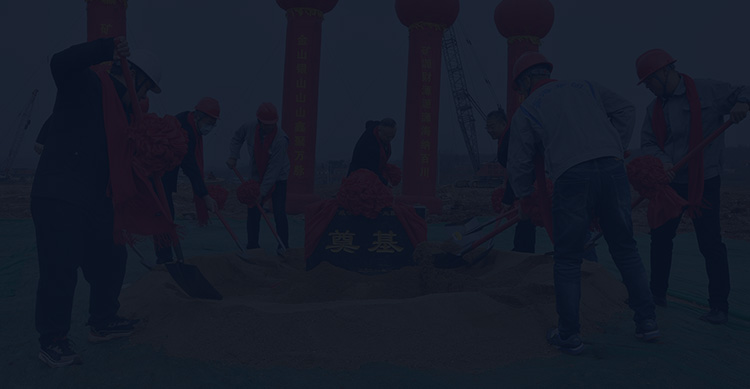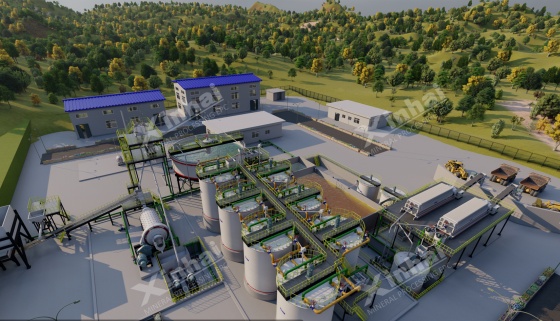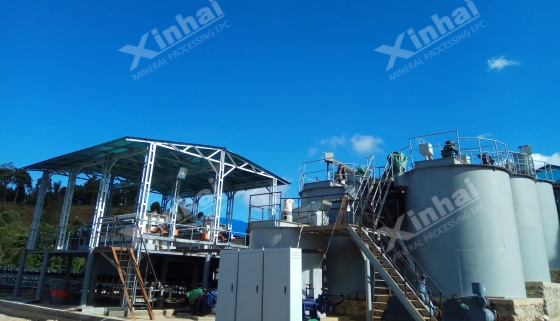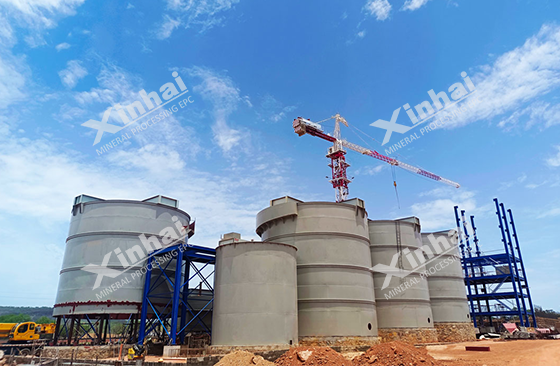
The principle of gold cyanidation is to use a cyanide solution to dissolve the gold in gold ore. According to statistics, 90% of the world's gold production comes from gold cyanidation. This method has a long history and was introduced as early as 1887. With the advancement of technology, it has now developed from the traditional leaching process to CIP and CIL processes. It not only improves the gold recovery rate but also enhances production efficiency and reduces operational difficulty. This article introduces the types, process flow, and precautions for gold cyanidation plant construction.

1. Agitation Leaching
The cyanidation stirring method is suitable for high-grade, easy-to-leach, fine-grained gold ores. The principle is to mix the milled gold ore slurry with a sodium cyanide (NaCN) solution in a stirring tank and dissolve the gold by aeration and oxidation. This method offers high leaching efficiency, and the gold leaching rate can exceed 90%.
2. Heap Leaching
Heap leaching is suitable for low-grade ores (gold content<1 g/t), oxidized ores, or tailings. The principle involves piling the ore on an impermeable pad, spraying it with a cyanide solution, and allowing the gold to flow into a collection pool with the solution. This method has a low investment cost and is suitable for large-scale production. However, the leaching cycle can take several weeks to several months, and the recovery rate is typically only 50%–80%.
3. Percolation Leaching
Percolation leaching is suitable for porous, permeable, blocky, or coarse-grained ores. The principle involves loading the ore into a percolation tank, where the cyanide solution penetrates the ore layer from top to bottom to dissolve the gold. The advantages of this method are simple equipment and low energy consumption, but the processing capacity is small, and the ore must have good permeability.

4.Carbon in Pulp (CIP)
The carbon-in-pulp (CIP) method is suitable for ores containing fine gold or complex components. The principle is to add activated carbon to the pulp after cyanide leaching, allowing the dissolved gold to be extracted through countercurrent adsorption. The advantages of this gold cyanidation method include a simplified process that eliminates the need for solid-liquid separation, direct gold adsorption, and the ability to regenerate and recycle the activated carbon.
5.Carbon in Leach (CIL)
The scope of application for carbon in leaching is similar to that of the CIP method, but it is more suitable for ores containing interfering substances. The principle is to add activated carbon directly into the cyanide leaching tank, allowing leaching and adsorption to occur simultaneously. The advantages of this method are a shorter process and reduced gold loss. However, during operation, careful control of the cyanide concentration and the activity of the activated carbon is required.
In addition to the methods mentioned above, gold cyanidation techniques also include the resin-in-pulp (RIP) method, pressurized cyanidation, and bio-cyanidation (Bio-Cyanidation). When selecting a method, it is essential to comprehensively consider ore properties, economic efficiency, and environmental protection requirements to choose the most suitable approach.
1. Ore pretreatment
First, after underground or open-pit mining, crush the gold ore to -200 mesh (0.074 mm), with more than 80% passing this size. This increases the contact area between the gold and the cyanide solution.For refractory ores, an oxidation pretreatment can also be added, including roasting, biological oxidation, or pressurized oxidation.
2. Cyanide leaching
Next, the pretreated gold ore is thoroughly mixed with a sodium cyanide (NaCN) solution, with oxygen added to participate in the reaction. Gold dissolves to form gold-cyanide complexes. During this process, it is important to control the pH value (10–11), cyanide concentration (0.01%–0.05%), and adjust the leaching time according to the process type.
The leaching time for agitation (stirred) cyanidation is typically 24–48 hours, while heap leaching requires a much longer period, often taking several weeks or even months.
3. Separation and enrichment of precious liquid
The gold-cyanide complexes produced after leaching are separated from the tailings through concentration, filtration, or washing. In the activated carbon adsorption method (CIP/CIL), gold is enriched on the surface of activated carbon by adsorbing gold-cyanide complexes. In the zinc precipitation method, zinc powder is used to displace gold from the pregnant solution.

4. Recovery and refining of gold
For the gold adsorbed onto activated carbon, gold is desorbed using a NaOH and sodium cyanide solution under high temperature and pressure. The resulting gold sludge is then deposited in the electrolytic cell, with a purity of about 90%.
For the newly replaced gold sludge, impurities are first removed by acid washing. Afterward, the solvent is added, and the gold is smelted at high temperature to obtain crude gold ingots with a purity of approximately 85% to 90%.
Electrolytic refining involves using crude gold as the anode, pure gold as the cathode, and a silver nitrate electrolyte to produce gold with a purity of over 99.9%. In addition, the chemical refining method uses aqua regia dissolution and reduction for further purification.
5. Tailings and wastewater treatment
After gold extraction, the tailings are first treated with bleaching powder, hydrogen peroxide, and ozone to decompose the residual cyanide. The treated tailings are then stored in the tailings pond.
After wastewater treatment, it is returned to the leaching process to conserve water resources. Additionally, microorganisms are used to degrade cyanide and heavy metals.
1. Preliminary Planning and Site Selection
The location of the gold cyanidation plant is critical. It should be situated close to the mine to minimize transportation costs and ensure a stable supply of water and electricity. Additionally, the plant should avoid proximity to water sources, nature reserves, and other sensitive areas, while prioritizing sites with flat terrain to facilitate the construction of tailings ponds.
In the early stages, an ore characteristics analysis should be conducted to help determine the optimal direction for the mineral processing process.

2. Process Design and Equipment Selection
Based on the results of the mineral processing test, the gold cyanidation process is determined. Next, key equipment should be selected and installed, including crushing equipment, grinding equipment, leaching equipment, and adsorption and recovery equipment.
Additionally, an online monitoring system should be implemented to continuously monitor parameters such as pH, cyanide concentration, and oxygen content. It is recommended to use a Distributed Control System (DCS) to reduce the risk associated with manual operation.
3. Environmental Protection and Safety Management
Given the high toxicity of cyanide, the storage and use of cyanide should be carefully considered during the construction of the gold cyanidation plant. Special storage facilities, emergency leak containment pools, and neutralizing agents should be provided.
Wastewater should be classified, and a closed-loop circulation system should be implemented. Additionally, a wastewater reuse system should be designed to minimize the consumption of fresh water.
4. Cost Control and Economic Efficiency
When constructing a plant, it is essential to focus on controlling both investment and operating costs. When selecting equipment, key equipment should be chosen from well-known manufacturers, while auxiliary equipment can be selected based on cost-effectiveness. During operation, it is important to control reagent consumption, minimize waste, and opt for energy-efficient ball mills for high grinding energy consumption, which can save 20%-30% of energy.
The above section outlines the types and processes of gold cyanidation, as well as the key considerations when establishing a gold cyanidation plant. Xinhai Mining has 30 years of experience in gold ore beneficiation and has served mines in over 100 countries and regions worldwide. Xinhai’s EPC+M+O service provides a full range of solutions, from ore dressing tests and equipment installation to concentrator operation. For mining equipment or project services, please contact us.
To find out more about our products and solutions, please fill out the form below and one of our experts will get back to you shortly.